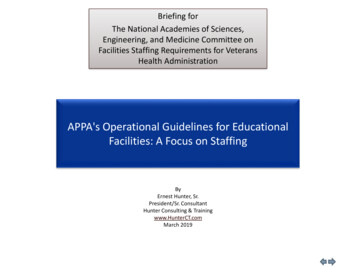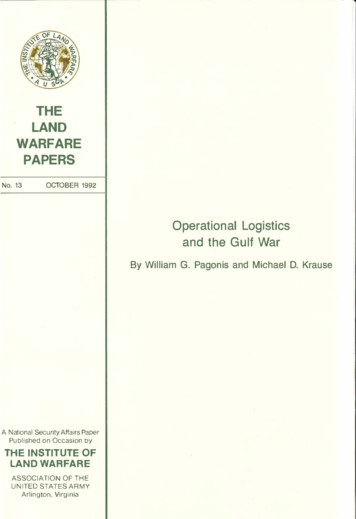
Transcription
Briefing forThe National Academies of Sciences,Engineering, and Medicine Committee onFacilities Staffing Requirements for VeteransHealth AdministrationAPPA's Operational Guidelines for EducationalFacilities: A Focus on StaffingByErnest Hunter, Sr.President/Sr. ConsultantHunter Consulting & Trainingwww.HunterCT.comMarch 2019
Table of ContentsBackgroundGeneral Staffing ConceptDetailed APPA Staffing GuidelinesConcept: CustodialDetailed APPA Staffing GuidelinesConcept: MaintenanceReference Slides2
Background
About APPA APPA (formerly Association of Physical Plant Administrators) mission1 With one eye on providing excellence in today’s educational environment,and one always trained on adapting, enhancing, and transforming thefacilities of the future, APPA seeks to create positive impact in educationalfacilities on three important levels: APPA transforms individual facilities professionals into higher performingmanagers and leaders, which Helps transform member institutions into more inviting and supportive learningenvironments, which Elevates the recognition and value of educational facilities and their direct impacton the recruitment and retention of students, faculty and staff. APPA is the de facto official keeper of the facilities management body ofknowledge for K-12, Colleges and Universities facilities managementprofessionals.1Source : APPA web site at www.appa.org4
Operational Guidelines Staffing General Concept Staffing Concept Contained in APPA Operational Guidelines Trilogy: Operational Guidelines for Educational Facilities: Custodial; Operational Guidelines for Educational Facilities: Grounds; Operational Guidelines for Educational Facilities: Maintenance; Media for Trilogy Content (3 books and support software): Print Book; eBook; Operations and Staffing software package available for each book;5
General Staffing Concept6
Operational Guidelines Staffing General ConceptCustodial APPA Operational Guidelines Staffing General Concepts for Custodial: Task-Time-Frequency (TT&F) method, based on Common Tasks, Timeto Perform, Frequency of performance and size of space being cleaned; Common list of tasks to be performed for each type of building space(e.g.: Office, Classroom, Washroom, etc.); Average “time to clean” for each task; Frequency at which the tasks are performed is driven by desired level ofcleanliness (APPA has defined five levels of cleanliness); Total time to clean is directly related to frequency at which the tasks areperformed and the size of the space in Cleanable Square Feet (CSF); Total time to clean is directly proportional to the size of the space; FTEs are driven by total time to clean adjusted by the workforce productivity.7
Operational Guidelines Staffing General ConceptGrounds APPA Operational Guidelines Staffing General Concepts for Grounds: Task-Time-Frequency (TT&F) method, based on Common Tasks, Timeto Perform, Frequency of performance and size of area; Common list of tasks to be performed for each type of grounds area(e.g.: Flowerbed, Softball field, Turf Area, etc.); Average “time to perform” for each task; Frequency at which the tasks are performed is driven by desired level ofappearance (APPA has defined six levels of cleanliness); Total time to perform is directly related to frequency at which the tasks areperformed and the size of the grounds area; Total time to perform is directly proportional to the size of the grounds area; FTE requirements driven by total time to perform adjusted by the expectedproductivity of the workforce, and green space growing season.8
Operational Guidelines Staffing General Concept ForMaintenance APPA Operational Guidelines Staffing General Concepts for MaintenanceAggregate FTE Method: Statistical-parametric method – unlike Custodial and Grounds, basedon statistical information and facilities portfolio parameters ; Based on the following parameters: Net assignable square feet (NASF) of space in maintained buildings; Space type profile (e.g.: offices, classrooms, laboratories and residence halls); Adjustment Factors: Overall campus size; Age of facilities; Variety in types of buildings; Condition of facilities; Variety in mission of organization;9
Detailed APPA Staffing GuidelinesConcept: Custodial10
Detailed APPA Staffing Guidelines Concept: Custodial Cleaning industry and higher education facilities managementcommunity accepted guidelines and protocols: APPA1, the association for higher education facilities professionals, publishedCustodial Operational Guidelines for Educational Facilities (APPA Guidelines); APPA Guidelines provide custodial services organizations with standardconcepts and protocols, for staffing and managing the cleaning function; APPA Guidelines book, in its third edition, has been in the public domain formany years; APPA Guidelines book was updated to third edition in 2011; APPA Guidelines is accepted by the higher education and commercial cleaningindustry as a “de facto” standard for custodial operations and staffing; Estimating Process informed by ISSA2 cleaning estimating times book; The concepts and protocols are contained in the APPA Guidelines – clickon the below icons to learn more.1Custodial Operational Guidelines for Educational Facilities (APPA Guidelines) – this is a publication of custodial staffing andmanagement concepts and protocol that have been in the public domain for many years and has been accepted by the highereducation and commercial cleaning community as a “de facto” standard for managing cleaning operations (see www.APPA.org).2Professional association for the worldwide cleaning industry.11
APPA Custodial FTE Estimating ProtocolInputs, Process, and Outputs APPA Guidelines Key Components: Define cleanliness APPA Level-1 through APPA Level-5 (Level-1 is best, and Level-5is worst); Provide lists of cleaning tasks and the performance frequency for differentcategories of spaces to achieve the five cleanliness levels; Provide normalized “time to perform” guidelines for tasks from ISSA 540 CleaningTimes1 adopted to higher education cleaning environments, normalized to theaverage custodial organization found in educational institutions; Provide a protocol for determining the FTEs and budget needed to achieve thedesired cleanliness level by average organizations; Provide an audit and inspection protocol for quality assurance, and fordetermining what cleanliness level is actually being achieved.1ISSA 540 Cleaning Times – published by ISSA, The Worldwide Cleaning Industry Association, and is anindustry accepted reference for estimating how much time it takes to perform cleaning tasks (www.ISSA.com).12
APPA Custodial Service Levels13
APPA Custodial FTE Estimating ProtocolCustodial Staffing – Example APPA Standard Space Matrix The APPA FTE and budgetestimating protocol makes adirect connection betweencleaning tasks to beperformed, base time toperform them, frequency atwhich they are to beperformed, and the level ofcleanliness to expect: Higher levels of cleanliness requirehigher frequencies of performance; Higher frequencies of performancerequire more FTEs and budget; Tasks and frequencies to achieveeach cleanliness level based ontime studies and empirical datacollected by APPA from a largepopulation of colleges anduniversities when the protocol wasdeveloped.Classroom with Hard Floor Standard Space MatrixRoutine ActivitiesSpot clean walls and doorsRelampClean chalkboards and traysDust flat surfacesEmpty waste containersEmpty pencil sharpenersSweep, dust-mop floorsClean erasersLevel 1 Level 2 Level 3 Level 4 Level /DA/DD/AA/DA/DA/DA/DTotal Base TimeProject ActivitiesDust blindsProject-clean furniture and seatingClean trash containersDust ventsPerform interim floor careStrip/refinish floorsClean windowsProject-clean light fixturesSpray-buff/burnish floorsDamp-mop floorsLevel 1 Level 2 Level 3 Level 4 Level Total Base TimeBase Square Feet: 1,200 16.61482.63Base Time in Minutes(D Daily, , A/D Alternate Days, W Weekly, M Monthly, Q Quarterly, A Annual, etc., D/A Special notation for relamping based expected lamp life cycle. )14
Custodial FTE Estimating Process SummaryCustodial Cleanable Square Feet (CSF)Inventory2 by Space Type (classrooms,washrooms, entranceways, offices,etc.): Building;Floor;Space ID (e.g.: room number);Cleanable Square Feet (CSF);Desired Cleanliness Level;Local Variables: 1.2.3.4.Average days worked per year;Average productive minutes per day;Average wage rate;Average benefits rate.ProcessFTE andBudgetEstimating: Standard tasksandfrequencies; Standard“times toperform” fortasks;Outputs1AdjustResults: FTEs andBudgetrequirementfor cleaningworkers onlyexcludingadditionalduties2 andsupervision. Standardparameters formaterials andequipmentcost.Cost of Cleaning andIn-house FTEsInputsFTEs and budget for supervision and additional duties assigned to the personnel responsible for the core function must beadded to the estimating protocol output to derive the total requirement.Estimates are based on SDSU cleanable square feet data developed by the SDSU and review by the Consultants.Further refinement and upkeep of the Cleanable Square Feet Inventory data set is necessary in order to derive full benefitsfrom the information.Examples of additional duties are custodians (i) performing special event support; (ii) performing snow removal; (iii)hanging pictures or moving furniture; and (iv) preparing dorm room after change of occupant and between semesters.15
Detailed APPA Staffing GuidelinesConcept: Maintenance16
APPA Staffing Guidelines Concept: Maintenance Higher education facilities management community accepted guidelinesand protocols: APPA, the association for higher education facilities professionals, publishedMaintenance Operational Guidelines for Educational Facilities (APPA Guidelines); APPA Guidelines provide facilities maintenance organizations with standardconcepts and protocols for staffing and managing the maintenance function; APPA Guidelines book is in its second edition and has been in the public domainfor many years; APPA Guidelines book was updated to second edition in 2011; APPA Guidelines accepted by the higher education facilities maintenanceorganizations as a de facto standard for maintenance operations and staffing; Further detail can be found in the Reference Slides section beginning with theslide sub-titled APPA Guidelines Maintenance Profile Concept.1Maintenance Operational Guidelines for Educational Facilities (APPA Guidelines) – this is a publication of facilities maintenancestaffing and management concepts and protocol that have been in the public domain for many years and has been accepted by thehigher education facilities maintenance community as a de facto standard for managing facilities maintenance operations (seewww.APPA.org).17
APPA Staffing Guidelines Concept: Maintenance Interpreting APPA Staffing and Cost Estimating Results: APPA has developed staffing guidelines for facilities maintenance based on the type ofspace to be maintained and the level of services to be provided; More staffing is needed for more complex spaces and for higher service levels; Older facilities and heavy use facilities will also require greater staffing; Services can be provided by either in house staff or contractors, or a combination; Contracted Equivalent FTEs must be accounted for when estimating the facilitiesmaintenance total in-house FTE needs. Contracted cost can be converted to estimatedContracted Equivalent FTEs based on wage rates and other known labor costs; The staffing guidelines are based on “an average organization performing an averagerate of employee productivity;” Best practice organizations can surpass the defined APPA guidelines; Best practice organizations employ technology, fine tuned processes, strongmanagement practices and training to support their employees in achieving a higherlevel of productivity.18
Maintenance FTE Estimating Process Summary1.2. Gross Square Feet (GSF) by spaceuse category (classrooms,residence halls, labs offices, etc.); Adjustment factors for: Campus Size Campus Age Varying Building Types Deferred Maintenance Levels Campuses of Varying Missions Average days worked per year. Average productive minutes perday. Average wage rate. Average benefits rate.Process Space profileand empiricalparameterbasedestimation; Standardparameters formaterials,spare parts andequipmentcost; FTE per GSFbased on spacetype.Outputs1 Total FTEsand BudgetRequirementfor corefunctionregardless ofmethod ofservicedelivery (inhouse es.Adjust To estimatetotal in-houseFTEs, addsupervisionand additionalduties FTEsand subtractcontractedservices FTEequivalent.Cost of Service and Inhouse FTEsInputs To estimatetotal budget,add cost ofsupervisionand cost ofadditionaldutiesactivities.FTEs and budget for supervision and additional duties assigned to the personnel responsible for the core function must be added tothe estimating protocol output to derive the total requirement.Examples of additional duties are Maintenance workers (i) performing special event support; (ii) performing snow removal; (iii)hanging pictures or moving furniture; and (iv) performing renovation projects.19
Reference Slides20
FTE And Budget Estimating Guidelines and ProtocolAPPA Guidelines Maintenance Profile Concept1Overlaps and Interrelationships in Types ofMaintenanceMaintenance is also a continuum of activities thatrange from predicting or preventing (PM) to capitalimprovements or renovations, with repairs and“support maintenance” involving operationalactivities in the middle1.1Maintenance Activities as a Percentage of TotalResources (example profile)The percentage of effort spent on the various types ofmaintenance activities is dependent on the servicelevel the maintenance organization is staffed andfunded to achieve. At the worst extreme alleffort is consumed by emergencies. At the bestextreme most activities are planned.Source: Excerpt from APPA Operational Guidelines for Educational Facilities, Maintenance Second Edition.21
FTE And Budget Estimating Guidelines and ProtocolLevels of Maintenance Narrative Description1Level 1: Showpiece Facility. Maintenance activities appear highly focused. Typically, equipment and building componentsare fully functional and in excellent operating condition. Service and maintenance calls are responded to immediately. Allregulatory submittals and requirements are met at or before submission dates. Buildings and equipment are regularlyupgraded, keeping them current with modern standards and usage.Level 2: Comprehensive Stewardship. Maintenance activities appear organized, with direction. Equipment and buildingcomponents are usually functional and in operating condition. Service and maintenance calls are responded to in atimely manner. All regulatory submittals and requirements meet submission dates. Buildings and equipment areregularly upgraded, keeping them current with modern standards and usage.Level 3: Managed Care. Maintenance activities appear to be somewhat organized, but remain people-dependent.Equipment and building components are mostly functional but suffer occasional breakdowns. Service and maintenancecall response times are variable and sporadic without apparent cause. Regulatory submittals and requirements typicallymeet submission dates, with some occasional short delays. Buildings and equipment are periodically upgraded to currentstandards and use, but not enough to control the effects of normal usage and deterioration.Level 4: Reactive Management. Maintenance activities appear somewhat chaotic and are people dependent. Equipmentand building components are frequently broken and inoperative. Service and maintenance calls are typically notresponded to in a timely manner. Regulatory submittals and requirements with the largest operational impact meetsubmission dates, but those that have less of an impact are typically late. Normal usage and deterioration continuesunabated, making buildings and equipment inadequate to meet present use needs.Level 5: Crisis Response. Maintenance activities appear chaotic and without direction. Equipment and buildingcomponents are routinely broken and inoperative. Service and maintenance calls are never responded to in a timelymanner. Regulatory submittals and requirements with the largest operational impact typically submitted late, with otherrequirements ignored unless cited. Normal usage and deterioration continues unabated, making buildings andequipment inadequate to meet present use needs.22
FTE And Budget Estimating Guidelines and ProtocolAPPA FY 15-16 FPI Respondents Reported Maintenance Service LevelHigher Education Maintenance Service Level 10.0%Level 1Level 2Level 3Level 4Level 5Number of Respondents063122241Percent of Respondents0.0%30.0%58.1%11.4%0.5%0.0%Percent of Respondents Due to limited resources andconstrained budget, many collegesand universities have targeted APPALevel-3, or somewhere between APPALevel-3 and APPA Level-2;FY 15-16 APPA FPI Self-Reported FacilitiesMaintenance Service LevelNumber of Respondents APPA and higher education facilitiesmanagement community havetraditionally advocated APPA Level-2;Service Level 53 of 210 (30.0%) institutions in the FY16-16 APPA Facilities Performance Indicators (FPI)Survey1 reported achieving APPA Level-3, and the average level reported was 2.82; 122 of 210 (58.1%) institutions in the FY16-16 APPA Facilities Performance Indicators(FPI) Survey1 reported achieving APPA Level-3, and the average level reported was 2.82 This has been the trend for at least the last several FPI reports;1The APPA Facilities Performance Indicators (FPI) survey is conducted annually by APPA to collect comparative analysis facilitiesmanagement benchmark data from institutions through the U.S.A. and Canada (http://www.appa.org/Research/fpi.cfm).23
FTE And Budget Estimating Guidelines and ProtocolAPPA Facility Characteristics for Evaluating and Describing Levels of MaintenanceMaintenance Level Matrix1: There are many perspectives and viewpoints on the appropriate level of maintenance services that shouldbe performed at any given facility; Institutional priorities and the amount of resources available typically determine the final level ofmaintenance provided.; Some common characteristics can used to describe the campus level of maintenance and ; These characteristics can be used to establish an improvement goal for a higher level of maintenance oroperational support; They can also be used as benchmarks to monitor improvements, or provide indicators when makingfinancial decisions; APPA has developed thirteen such characteristics have been assembled into an extensive maintenancelevel matrix that allows for comparisons between each of the levels, as well as across the characteristics. The maintenance level matrix was developed to display facility characteristics in terms that are useful toboth the facilities professional and the non-facilities administrator; The matrix has five maintenance levels, with a general description of the essential characteristics onemight use to measure the effectiveness of maintenance and facilities operations at each level.1Source: Excerpt from APPA Operational Guidelines for Educational Facilities, Maintenance Second Edition.The following two slides illustrates how the matrix can be used to construct a visual of the current status ofmaintenance services being provided under existing conditions.24
FTE And Budget Estimating Guidelines and ProtocolAPPA Facility Characteristics for Evaluating and Describing Levels of MaintenanceSource: Figure 2.2, page 28, ‘APPA Operational Guideline: Maintenance.’25
FTE And Budget Estimating Guidelines and ProtocolAPPA Facility Characteristics for Evaluating and Describing Levels of MaintenanceAPPA Maintenance Service Levels3.54.03.53.02.53.53.53.03.53.026
Manage Care (APPA Level 3)Source: Figure 2.2, page 28, ‘APPA Operational Guideline:Maintenance.’27
Operational Guidelines Staffing General Concept Grounds 8 APPA Operational Guidelines Staffing General Concepts for Grounds: Task-Time-Frequency (TT&F) method, based on Common Tasks, Time to Perform, Frequency of performance and size of area; Common list of tasks to be performed for each type of grounds area (e.g.: Flowerbed, Softball field, Turf Area, etc.);










